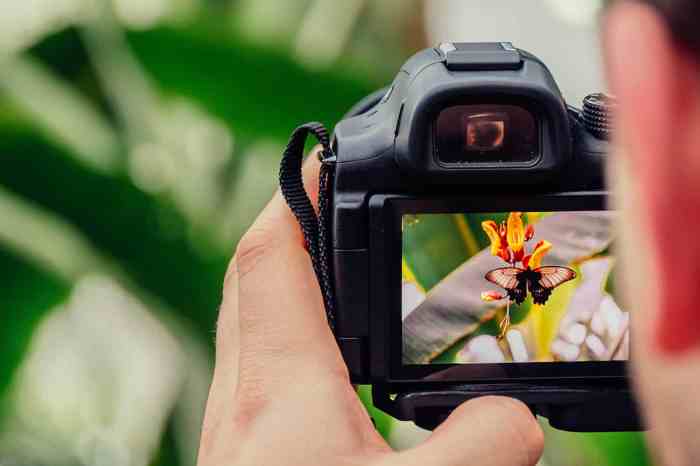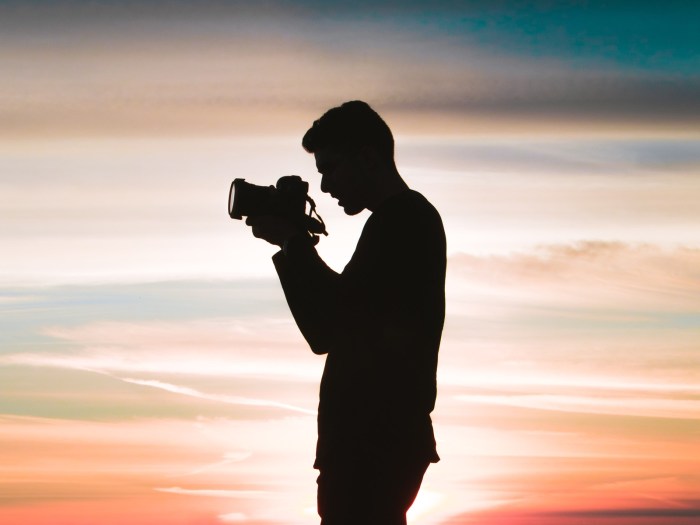Photography Tips for Beginners: Get ready to level up your photography game with these essential tips covering everything from camera settings to editing techniques. Whether you’re just starting out or looking to improve your skills, this guide has got you covered.
Are you ready to dive into the world of photography and unleash your creativity? Let’s explore the key tips that will help you capture stunning images and elevate your photography skills to the next level.
Importance of Photography Tips for Beginners
As a beginner in the world of photography, it is crucial to seek out tips and advice to enhance your skills and knowledge in this creative field. By learning from experienced photographers and following valuable tips, beginners can improve their photography techniques and take their images to the next level.Photography tips are essential for beginners as they provide guidance on how to avoid common mistakes that many new photographers tend to make.
Whether it’s understanding composition, lighting, or camera settings, these tips can help beginners navigate the technical aspects of photography and produce better quality images.Following photography tips can also boost the confidence and creativity of beginners. By implementing new techniques and experimenting with different styles, beginners can uncover their unique artistic vision and develop a signature photography style. Tips on editing, framing, and storytelling can inspire beginners to think outside the box and push their creative boundaries.
Learning Composition Techniques
Understanding the principles of composition, such as the rule of thirds, leading lines, and framing, can greatly improve the overall look and impact of your photos. By applying these techniques, beginners can create visually appealing and engaging images that capture the viewer’s attention.
- Use the rule of thirds to create a balanced and visually interesting composition.
- Experiment with leading lines to guide the viewer’s eye through the image.
- Consider framing your subject within the scene to add depth and context to your photos.
Basic Camera Settings Explained
Understanding basic camera settings is crucial for beginners to capture high-quality photos. Let’s delve into the essential settings like aperture, shutter speed, and ISO, and how they impact the final image.
Aperture
The aperture setting controls the amount of light that enters the camera lens. A lower f-stop number (e.g., f/2.8) means a larger aperture opening, allowing more light to reach the sensor. This setting also affects the depth of field, with lower f-stop numbers creating a blurry background (shallow depth of field) and higher f-stop numbers keeping more of the scene in focus (deep depth of field).
Shutter Speed
Shutter speed determines the amount of time the camera’s shutter remains open to capture an image. A faster shutter speed (e.g., 1/1000) freezes motion, while a slower shutter speed (e.g., 1/30) creates motion blur. Adjusting the shutter speed is crucial for capturing action shots or long-exposure photos.
ISO
ISO measures the camera sensor’s sensitivity to light. A lower ISO (e.g., 100) is ideal for bright conditions, while a higher ISO (e.g., 1600) is suitable for low-light situations. However, higher ISO settings can introduce digital noise, affecting the image quality. Finding the right balance between ISO and lighting conditions is essential.
Composition Techniques for Beginners

When it comes to photography, composition is key to creating visually appealing and engaging photos. By understanding and implementing different composition techniques, beginners can take their photos to the next level. Let’s dive into some essential composition techniques for beginners.
Rule of Thirds
The rule of thirds is a fundamental principle in photography that involves dividing your frame into nine equal parts using two horizontal and two vertical lines. The main subject or points of interest should be placed along these lines or at their intersections, rather than in the center. This technique helps create a more balanced and dynamic composition.
Leading Lines and Framing
Leading lines are elements within a photo that lead the viewer’s eye towards the main subject. These can be roads, fences, or any other lines that naturally draw the eye. Framing involves using elements in the foreground to frame the main subject, adding depth and context to the image. Both techniques help guide the viewer’s gaze and create a sense of depth in the photo.
Symmetry, Patterns, and Angles
Symmetry can create a sense of balance and harmony in a photo, while patterns add visual interest and repetition. Experimenting with different angles, such as shooting from low or high perspectives, can add a unique and dynamic element to your photos. By incorporating symmetry, patterns, and angles into your compositions, you can create captivating and visually appealing shots.
Tips for Better Lighting in Photography

Lighting is a crucial element in photography that can make or break a shot. Understanding how to work with both natural and artificial light sources can greatly improve the quality of your photos.
Importance of Natural Light
Natural light is often the most flattering and versatile light source for photography. It provides a soft, even illumination that can enhance the colors and details in your photos. To make the most of natural light, try shooting during the golden hours of sunrise and sunset when the light is warm and diffused. Position your subject so that the light is hitting them from the side for a more flattering effect.
Techniques for Using Artificial Lighting
When natural light is not available or sufficient, artificial lighting sources can be used to create the desired lighting effects. Experiment with different types of lighting equipment such as continuous lights, strobes, or speedlights to achieve the look you want. Consider factors like the intensity, direction, and color temperature of the light to create the desired mood in your photos.
Avoiding Harsh Shadows and Overexposure
To avoid harsh shadows in your photos, try diffusing the light source by using modifiers like umbrellas, softboxes, or reflectors. This helps to create a softer, more flattering light that reduces the contrast between light and shadow. Additionally, be mindful of overexposure by adjusting your camera settings to ensure proper exposure. Use the histogram on your camera to check for any areas that are blown out or too dark, and make adjustments as needed to achieve a well-balanced exposure.
Editing Tips for Beginners
When it comes to editing your photos, having the right tools and techniques can make a huge difference in the final result. Here are some tips to help beginners get started with editing their photos.
Popular Editing Tools and Software, Photography Tips for Beginners
- Adobe Lightroom: A popular choice for beginners, offering a wide range of editing tools and presets to enhance your photos.
- Photoshop Elements: A simplified version of Photoshop, perfect for beginners looking to make basic edits to their photos.
- GIMP: A free, open-source software that provides advanced editing features, great for beginners on a budget.
Basic Editing Techniques
- Adjusting Brightness: Alter the overall lightness or darkness of your image to improve exposure.
- Contrast Adjustment: Enhance the difference between light and dark areas to make your photos pop.
- Color Balance: Tweak the colors in your photo to achieve a more pleasing and natural look.
Importance of Non-Destructive Editing
Non-destructive editing allows you to make changes to your photos without altering the original image file, preserving the quality of your photos for future edits.
Saving Original Files
Always save a copy of your original photo before making any edits. This way, you can revert to the original if needed or start fresh with a clean slate.
Tips for Choosing the Right Gear
When starting out in photography, selecting the right gear is crucial to your success. Here are some tips to help beginners navigate the world of photography equipment.
Essential Gear for Beginners
- Camera Body: Invest in a DSLR or mirrorless camera body that fits your budget and needs. Consider factors like sensor size, resolution, and ease of use.
- Lenses: Start with a versatile lens like a 50mm prime lens or a standard zoom lens. As you progress, you can expand your collection based on your preferred photography style.
- Accessories: Don’t forget essential accessories like memory cards, camera bag, tripod, and cleaning kit to enhance your photography experience.
How to Prioritize Gear Purchases
- Assess Your Interests: Determine the type of photography you enjoy the most, whether it’s portrait, landscape, wildlife, or macro photography.
- Research Gear: Look into gear reviews, compare prices, and consider renting equipment before making a significant purchase.
- Budget Wisely: Allocate your budget based on your photography priorities. Invest in quality gear that will serve you well in the long run.
Understanding Gear Specifications
- Resolution: Learn about megapixels and how they affect image quality and printing sizes.
- ISO Range: Understand the camera’s sensitivity to light and how it impacts image noise in different lighting conditions.
- Focusing System: Familiarize yourself with autofocus points and tracking capabilities for sharp and accurate focusing.
Tips for Building a Photography Portfolio
Building a photography portfolio is crucial for beginners to showcase their skills and style to potential clients or collaborators. A well-curated portfolio can make a lasting impression and open up opportunities for future projects.
Importance of a Diverse Portfolio
Having a diverse portfolio is essential for beginners as it demonstrates versatility and creativity. It shows that you can work in different styles and genres, making you more appealing to a wider range of clients.
- Include a variety of subjects: Capture different types of subjects such as landscapes, portraits, still life, and events to showcase your range.
- Showcase different editing styles: Display photos with various editing techniques to highlight your editing skills and artistic vision.
- Demonstrate technical skills: Include photos that showcase your understanding of camera settings, lighting, and composition.
Selecting and Organizing Photos
When selecting photos for your portfolio, choose images that best represent your style and skills. Organize them in a cohesive manner to create a visually appealing presentation.
- Quality over quantity: It’s better to have a smaller selection of high-quality images than a large number of mediocre ones.
- Consider the flow: Arrange your photos in a way that tells a story or creates a visual journey for the viewer.
- Show your best work first: Start and end your portfolio with your strongest images to leave a lasting impression.
Showcasing Skills and Style
A well-curated portfolio can effectively showcase a beginner’s skills and style, helping them stand out in a competitive industry.
A portfolio is like a visual resume that speaks volumes about your creativity and technical abilities.
- Highlight your unique style: Choose photos that reflect your artistic vision and set you apart from other photographers.
- Demonstrate consistency: Ensure that your portfolio maintains a consistent style and quality throughout to build trust with potential clients.
- Update regularly: Keep your portfolio up to date with your latest work to show growth and improvement over time.